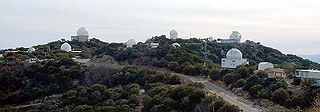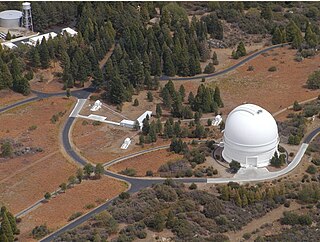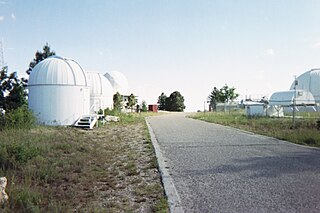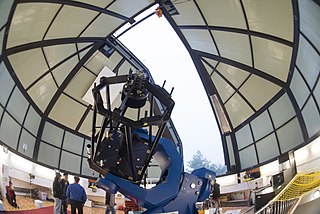
The Kitt Peak National Observatory (KPNO) is a United States astronomical observatory located on Kitt Peak of the Quinlan Mountains in the Arizona-Sonoran Desert on the Tohono O'odham Nation, 88 kilometers (55 mi) west-southwest of Tucson, Arizona. With more than twenty optical and two radio telescopes, it is one of the largest gatherings of astronomical instruments in the northern hemisphere.

Yerkes Observatory is an astronomical observatory located in Williams Bay, Wisconsin, U.S.A. It was operated by the University of Chicago Department of Astronomy and Astrophysics from its founding in 1897 to 2020. Ownership was transferred to the non-profit Yerkes Future Foundation (YFF) in May 2020, which began restoration and renovation of the historic building and grounds. Re-opening for public visits and programming is expected in 2022.

The Mount Wilson Observatory (MWO) is an astronomical observatory in Los Angeles County, California, United States. The MWO is located on Mount Wilson, a 1,740-meter (5,710-foot) peak in the San Gabriel Mountains near Pasadena, northeast of Los Angeles.

Palomar Observatory is an astronomical research observatory in San Diego County, California, United States, in the Palomar Mountain Range. It is owned and operated by the California Institute of Technology (Caltech). Research time at the observatory is granted to Caltech and its research partners, which include the Jet Propulsion Laboratory (JPL), Yale University, and the National Optical Observatories of China.

The McDonald Observatory is an astronomical observatory located near the unincorporated community of Fort Davis in Jeff Davis County, Texas, United States. The facility is located on Mount Locke in the Davis Mountains of West Texas, with additional facilities on Mount Fowlkes, approximately 1.3 kilometers (0.81 mi) to the northeast. The observatory is part of the University of Texas at Austin. It is an organized research unit of the College of Natural Sciences.

The Apache Point Observatory is an astronomical observatory located in the Sacramento Mountains in Sunspot, New Mexico, United States, approximately 18 miles (29 km) south of Cloudcroft. The observatory is operated by New Mexico State University (NMSU) and owned by the Astrophysical Research Consortium (ARC). Access to the telescopes and buildings is private and restricted.
Boyden Observatory is an astronomical research observatory and science education centre located in Maselspoort, 20 kilometres (12 mi) north-east of the city of Bloemfontein in Free State, South Africa. The observatory is managed by the Physics Department of the University of the Free State (UFS). The Friends of Boyden assist the observatory as a public support group, organising open evenings and protecting its public interest. Boyden also makes use of members of ASSA Bloemfontein Centre, the amateur astronomy club of the city, for presenters and telescope assistants.

Siding Spring Observatory near Coonabarabran, New South Wales, Australia, part of the Research School of Astronomy & Astrophysics (RSAA) at the Australian National University (ANU), incorporates the Anglo-Australian Telescope along with a collection of other telescopes owned by the Australian National University, the University of New South Wales, and other institutions. The observatory is situated 1,165 metres (3,822 ft) above sea level in the Warrumbungle National Park on Mount Woorat, also known as Siding Spring Mountain. Siding Spring Observatory is owned by the Australian National University (ANU) and is part of the Mount Stromlo and Siding Spring Observatories research school.

The Kopernik Observatory & Science Center (KOSC), is a public observatory in Vestal, New York opened to the public on 16 June 1974 by the Kopernik Society of Broome County to commemorate the 500th anniversary of the birth of the astronomer Nicolaus Copernicus in 1973. Its mission is to offer hands-on investigations and outreach programs for educating all ages about astronomy and science using advanced optical telescopes, computers and other tools. It is the first science laboratory facility in New York State designed for K-12 teachers, students and their families, and has been one of the best-sited and best equipped public observatories in the Northeast United States for nearly the last 40 years.

The Haleakalā Observatory, also known as the Haleakalā High Altitude Observatory Site, is Hawaii's first astronomical research observatory. It is located on the island of Maui and is owned by the Institute for Astronomy of the University of Hawai'i, which operates some of the facilities on the site and leases portions to other organizations. Tenants include the Air Force Research Laboratory (AFRL) and the Las Cumbres Observatory Global Telescope Network (LCOGTN). At over 3,050 meters (10,010 ft) in altitude, the summit of Haleakalā is above one third of the Earths's troposphere and has excellent astronomical seeing conditions.

The Kodaikanal Solar Observatory is a solar observatory owned and operated by the Indian Institute of Astrophysics. It is on the southern tip of the Palani Hills 4 km from Kodaikanal town, Dindigul district, Tamil Nadu state, South India.

The Allan I. Carswell Astronomical Observatory, formerly known as the York University Astronomical Observatory, is an astronomical observatory owned and operated by York University. It is located in the North York district of Toronto, Ontario, Canada. Opened in 1969, York's observatory is opened to both researchers and amateur astronomers. The observatory was renamed the Allan Ian Carswell Astronomical Observatory in 2017 after York University Emeritus Professor of Physics Allan Carswell.

Mount Lemmon Observatory (MLO), also known as the Mount Lemmon Infrared Observatory, is an astronomical observatory located on Mount Lemmon in the Santa Catalina Mountains approximately 28 kilometers (17 mi) northeast of Tucson, Arizona (US). The site in the Coronado National Forest is used with special permission from the U.S. Forest Service by the University of Arizona's Steward Observatory, and contains a number of independently managed telescopes.

Fuertes Observatory is an astronomical observatory located on the North Campus of Cornell University in Ithaca, New York. The observatory was designed by L.P. Burnham, Cornell Professor of Architecture and completed in fall of 1917. It was originally used by the Civil Engineering Department as an instructional field office for navigation and surveying. Today, the observatory is primarily used for public outreach, welcoming over two thousand visitors per year with open houses on clear Friday nights.

The Dearborn Observatory is an astronomical observatory located on the Evanston campus of Northwestern University. The observatory was originally constructed in 1888, through an agreement between the university and the Chicago Astronomical Society. In the summer of 1939, Dearborn Observatory had to be moved to make way for the construction of the Technological Institute.

The Lulin Observatory is an astronomical observatory operated by the Institute of Astronomy, National Central University in Taiwan.

The Meade LX200 is a family of commercial telescopes produced by Meade Instruments launched in 1992 with 8" (20.32 cm) and a 10" (25.4 cm) Schmidt–Cassegrain models on computerized altazimuth mounts. Two larger models, a 12" (30.48 cm) and a 16" (40.64 cm), quickly followed. The original version was later informally named the "classic" LX200 as newer upgraded versions replaced it. The first of these was the LX200GPS, which featured global positioning system electronics. A 360 mm (14 in) LX200GPS was later added to the line.

Three College Observatory (TCO) is an astronomical observatory owned and operated by The University of North Carolina at Greensboro (UNCG), North Carolina Agricultural and Technical State University, and Guilford College (GC). Built in 1979, it is located 10 kilometers (6 mi) south of Graham, North Carolina (USA), in the Cane Creek Mountains. The observatory, designed by W. Edward Jenkins, was funded with a $250,000 grant, however, it would cost $1.5 million to replace it today. The observatory's primary instrument is a 32 in (81 cm) Ritchey-Chrétien reflecting telescope attached to an equatorial mount. It was built by Sigma Research and installed at TCO in 1981. TCO is used by UNCG for instruction and outreach. It continues to be the largest telescope in North Carolina and ones of the largest telescopes in the southeast.

Bayfordbury Observatory is the University of Hertfordshire's astronomical and atmospheric physics remote sensing observatory, and one of the largest teaching observatories in the UK. It is located in the relatively dark countryside of Bayfordbury, Hertfordshire, 6 miles from the main university campus in Hatfield. The first telescope was built in 1969, and since then has been used as a teaching observatory for undergraduate students, staff and student research as well as for public outreach activities.
Judith Lynn Pipher was a Canadian-born American astrophysicist and observational astronomer. She was Professor Emerita of Astronomy at the University of Rochester and directed the C. E. K. Mees Observatory from 1979 to 1994. She made important contributions to the development of infrared detector arrays in space telescopes.


















